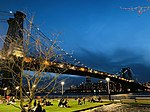Driggs Avenue station
1888 establishments in New York (state)1916 disestablishments in New York (state)Brooklyn railway station stubsDefunct BMT Jamaica Line stationsDefunct New York City Subway stations located aboveground ... and 3 more
Former elevated and subway stations in BrooklynRailway stations closed in 1916Railway stations in the United States opened in 1888
Driggs Avenue was a station on the demolished section of the BMT Jamaica Line in Brooklyn, New York City. This station was opened on June 25, 1888 as the terminal of the Broadway elevated. When the line was extended to Broadway Ferry on July 14, 1888, this ceased to be the terminal. Mainline BMT Jamaica Line service began providing direct service to Manhattan via the Williamsburg Bridge after 1908. The station finally closed on July 3, 1916, but the segment of the line remained dormant throughout the 1920s and 1930s before being demolished.This elevated station had two tracks and two side platforms.
Excerpt from the Wikipedia article Driggs Avenue station (License: CC BY-SA 3.0, Authors).Driggs Avenue station
Broadway, New York Brooklyn
Geographical coordinates (GPS) Address Nearby Places Show on map
Geographical coordinates (GPS)
| Latitude | Longitude |
|---|---|
| N 40.709902777778 ° | E -73.962272222222 ° |
Address
Broadway
11207 New York, Brooklyn
New York, United States
Open on Google Maps






